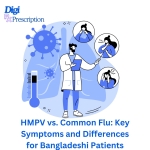
HMPV vs. Common Flu: Key Symptoms and Differences for Bangladeshi Patients
In Bangladesh, respiratory illnesses such as the Human Metapneumovirus (HMPV) and influenza (commonly known as the flu) are becoming more prevalent, particularly during winter. While both illnesses share similar symptoms, they differ significantly in severity, risk factors, and treatment approaches. Understanding the differences is crucial for early diagnosis and effective management.
This article highlights the key symptoms, differences, and preventive measures to help Bangladeshi patients stay informed and protected.
What is HMPV?
Human Metapneumovirus (HMPV) is a respiratory virus that causes symptoms ranging from mild cold-like illness to severe respiratory conditions such as pneumonia or bronchitis. It is particularly dangerous for:
- Young children.
- Older adults.
- Immunocompromised individuals.
Key Symptoms of HMPV:
- Cough.
- Nasal congestion.
- Shortness of breath or wheezing.
- Fever (mild to moderate).
- Fatigue.
- Severe cases: Difficulty breathing and lower respiratory tract infections.
What is the Common Flu?
Influenza, or the flu, is a highly contagious viral infection caused by influenza viruses. It spreads through respiratory droplets and can cause widespread outbreaks. The flu affects all age groups but poses higher risks to children, the elderly, and people with chronic illnesses.
Key Symptoms of the Flu:
- Sudden high fever.
- Body aches and chills.
- Sore throat.
- Dry or persistent cough.
- Fatigue and weakness.
- Headache.
- Runny or stuffy nose.
- Gastrointestinal symptoms (more common in children).
Key Differences Between HMPV and the Common Flu
| Feature | HMPV | Flu |
|---|---|---|
| Virus Type | Human Metapneumovirus (HMPV) | Influenza virus (Types A, B, C, and D) |
| Onset of Symptoms | Gradual onset | Sudden onset |
| Fever | Mild to moderate | High fever (often above 101°F/38.5°C) |
| Respiratory Symptoms | Nasal congestion, wheezing, difficulty breathing | Sore throat, dry cough |
| Body Aches | Rare | Common and severe |
| Contagiousness | Moderate | Highly contagious |
| Duration | 1–2 weeks | 1 week (mild) to several weeks (severe) |
| Severe Cases | Can lead to pneumonia or bronchitis | Can lead to complications like pneumonia, heart inflammation, or organ failure |
How to Differentiate Between HMPV and the Flu?
1. Consult a Doctor:
A healthcare professional can diagnose the illness based on symptoms, medical history, and physical examination.
2. Diagnostic Tests:
- For HMPV: PCR tests or respiratory viral panels can confirm the presence of HMPV.
- For Flu: Rapid influenza diagnostic tests (RIDTs) or laboratory-based molecular tests detect influenza viruses.
3. Severity of Symptoms:
If symptoms include severe breathing difficulties or sudden, high fever with body aches, immediate medical attention is necessary.
Treatment and Management
HMPV Treatment:
- There is no specific antiviral medication for HMPV.
- Treatment focuses on relieving symptoms:
- Rest and hydration.
- Use of over-the-counter fever reducers and pain relievers (e.g., paracetamol).
- Oxygen therapy or hospitalization for severe cases.
Flu Treatment:
- Antiviral medications such as oseltamivir (Tamiflu) or zanamivir can reduce symptoms and duration.
- Supportive care: Rest, hydration, and over-the-counter medication for fever and pain.
Prevention: Staying Safe in Bangladesh
HMPV Prevention:
- Practice good hygiene by washing hands frequently.
- Avoid close contact with infected individuals.
- Disinfect frequently touched surfaces.
- Wear masks in crowded places, especially during the winter months.
Flu Prevention:
- Get an annual flu vaccine.
- Maintain good hand hygiene and respiratory etiquette.
- Avoid large gatherings during peak flu season.
- Ensure proper ventilation in living spaces.
Why Understanding the Difference Matters
Misdiagnosis or delayed treatment can lead to severe complications, especially in high-risk groups such as children, the elderly, and people with pre-existing health conditions. Identifying whether the symptoms point to HMPV or the flu ensures timely medical intervention and better outcomes.
Conclusion
Both HMPV and the flu are significant health concerns in Bangladesh, especially during the winter season. Awareness of their key differences, symptoms, and preventive measures can help patients seek the right care and reduce the burden on healthcare systems. By following hygiene practices, leveraging vaccinations, and consulting healthcare providers early, you can protect yourself and your family this season.
Reliable Sources of Information
- World Health Organization (WHO): WHO Influenza Information
- Centers for Disease Control and Prevention (CDC): CDC on HMPV and Flu
- Directorate General of Health Services (DGHS), Bangladesh: DGHS Bangladesh
- icddr,b: Research on Respiratory Illnesses in Bangladesh
